The Impact of Personal Health Records on the Nursing Industry
VerifiedAdded on 2021/04/21
|7
|1477
|28
Report
AI Summary
This report examines the transformative impact of Personal Health Records (PHRs) on the nursing industry. It explores how PHRs, as electronic applications for storing patient data, enhance the healthcare environment by ensuring privacy, confidentiality, and security. The paper analyzes the benefits of PHRs in nursing practice, including improved patient care through accessible medical history, aiding in informed treatment decisions, and facilitating emergency care. The report also addresses the importance of data privacy and the ethical considerations for nurses in handling sensitive patient information. The conclusion emphasizes the overall positive influence of PHRs, highlighting their role in advancing medical care and promoting a safer, more efficient healthcare system. The report references key studies and sources to support its findings and recommendations.
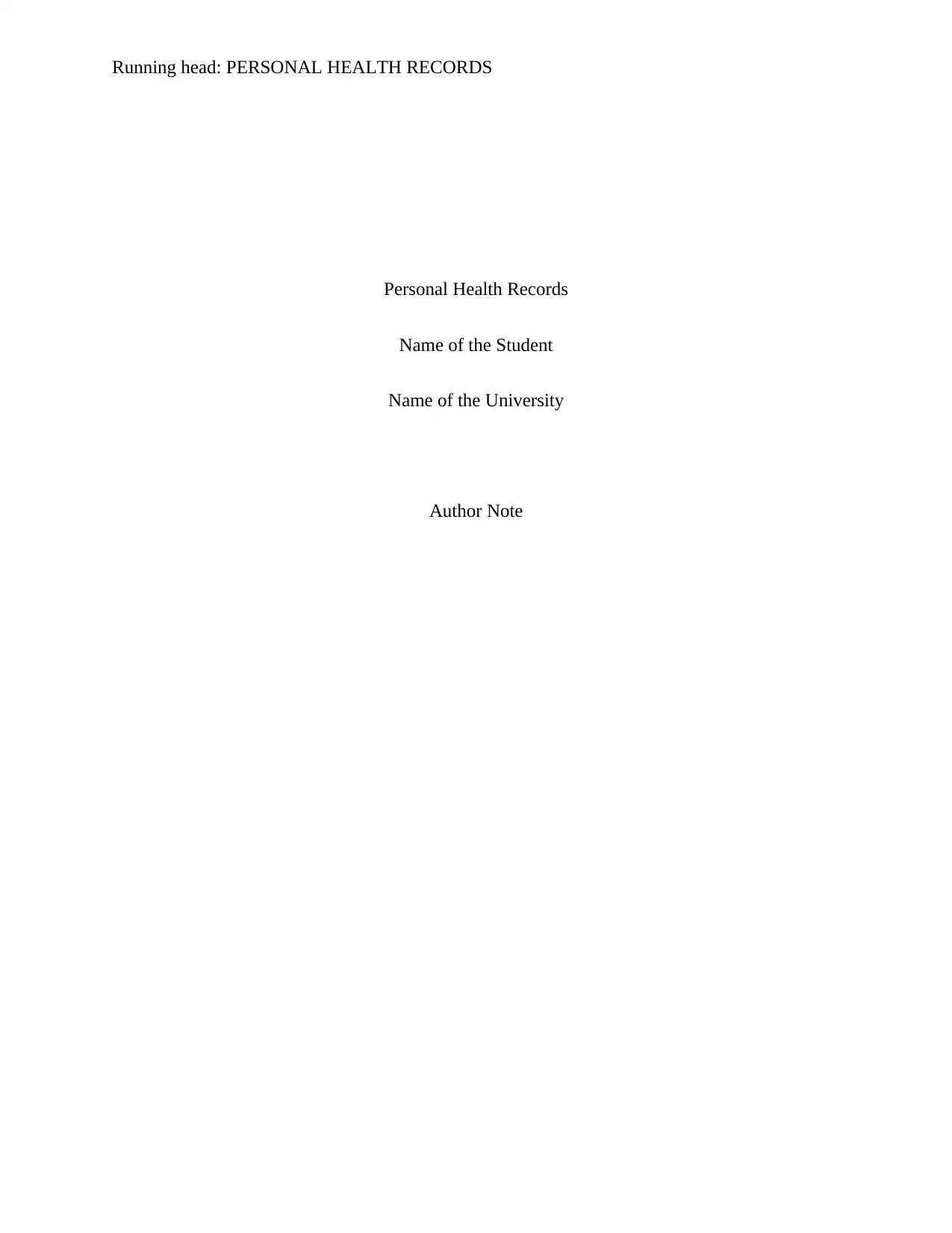
Running head: PERSONAL HEALTH RECORDS
Personal Health Records
Name of the Student
Name of the University
Author Note
Personal Health Records
Name of the Student
Name of the University
Author Note
Paraphrase This Document
Need a fresh take? Get an instant paraphrase of this document with our AI Paraphraser
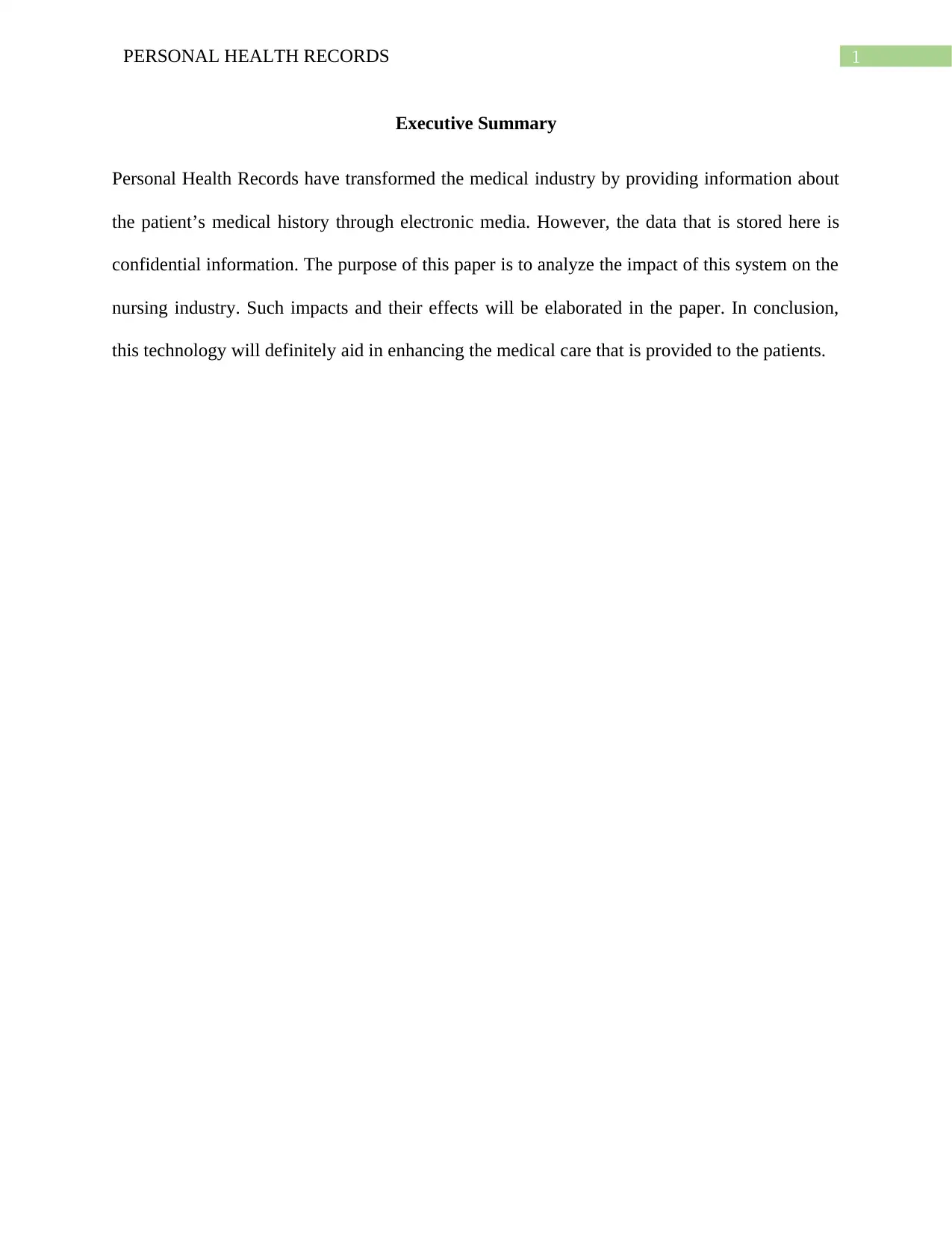
1PERSONAL HEALTH RECORDS
Executive Summary
Personal Health Records have transformed the medical industry by providing information about
the patient’s medical history through electronic media. However, the data that is stored here is
confidential information. The purpose of this paper is to analyze the impact of this system on the
nursing industry. Such impacts and their effects will be elaborated in the paper. In conclusion,
this technology will definitely aid in enhancing the medical care that is provided to the patients.
Executive Summary
Personal Health Records have transformed the medical industry by providing information about
the patient’s medical history through electronic media. However, the data that is stored here is
confidential information. The purpose of this paper is to analyze the impact of this system on the
nursing industry. Such impacts and their effects will be elaborated in the paper. In conclusion,
this technology will definitely aid in enhancing the medical care that is provided to the patients.
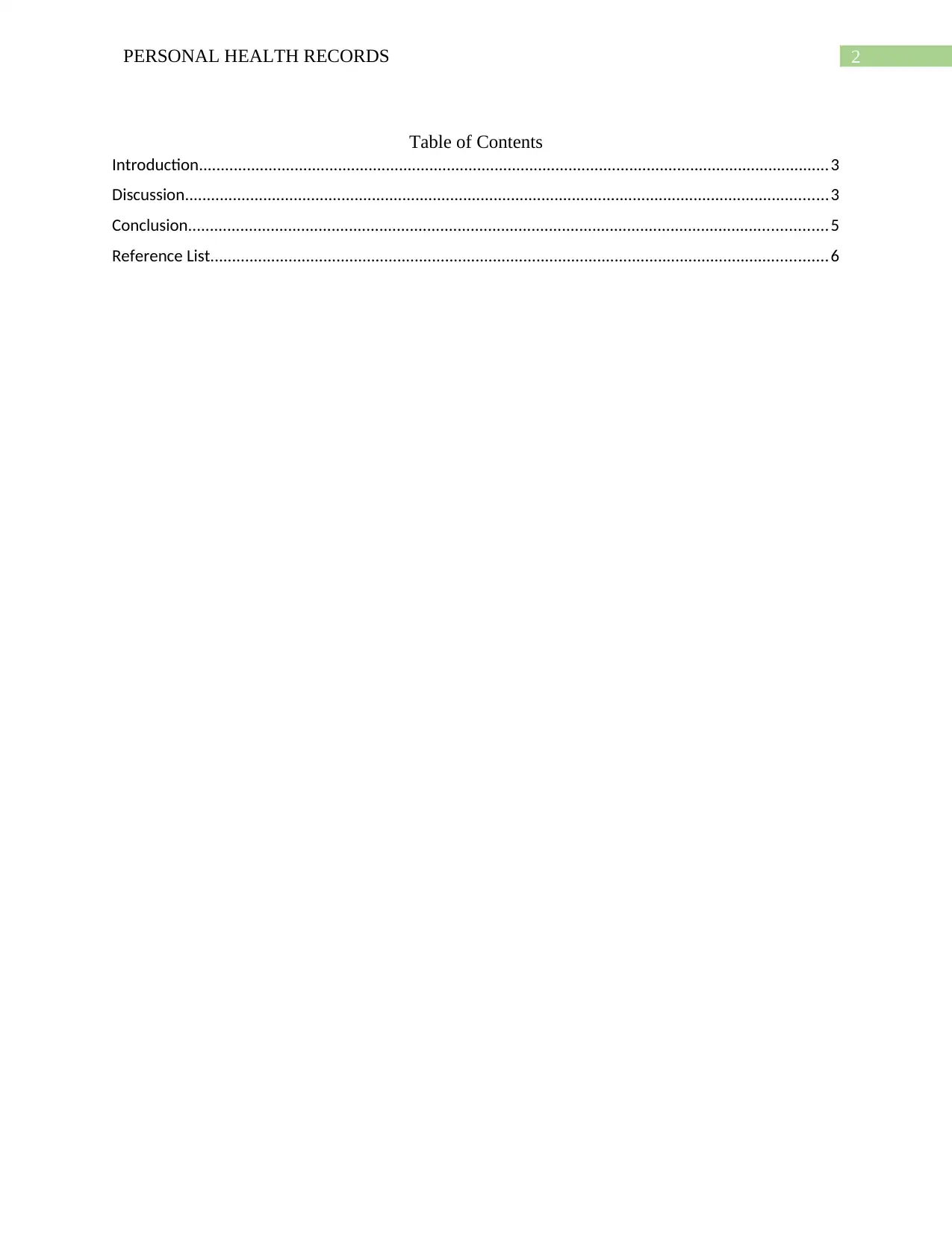
2PERSONAL HEALTH RECORDS
Table of Contents
Introduction.................................................................................................................................................3
Discussion....................................................................................................................................................3
Conclusion...................................................................................................................................................5
Reference List..............................................................................................................................................6
Table of Contents
Introduction.................................................................................................................................................3
Discussion....................................................................................................................................................3
Conclusion...................................................................................................................................................5
Reference List..............................................................................................................................................6
⊘ This is a preview!⊘
Do you want full access?
Subscribe today to unlock all pages.

Trusted by 1+ million students worldwide

3PERSONAL HEALTH RECORDS
Introduction
The healthcare sector has been revolutionized by the various advances in digital
technology that has aided in creating a medically enhanced environment for the patients.
Personal Health Record or PHR is one such technology where the patients can store their data
digitally. This electronic application is easy to use and stores the data in an environment that
ensures privacy, confidentiality and security. The most appealing feature of this application is
that the system is maintained by the patients themselves. The purpose of this paper is to research
and analyze the application of Personal Health Records in the nursing industry. This paper
consists of an analysis of the PHR systems and the ways in which it can be used to enhance the
healthcare industry.
Discussion
Nursing practice has been made safe by the use of technologies for patient care, the
information system and the different communication devices. The nurses use various easy to use
technologies such as a catheter and come complex technologies such as the barcode system that
aids in medication administration. These devices have changed the procedures that are used for
treating the patients. The introduction of the Personal Health Record system had a positive
impact on the patient care system (Hebda & Czar, 2013). The information system and the
devices for communication thus aids and supports the practice for safe nursing techniques. The
information system is very necessary for providing the best possible care to the patients. The
nurses can use this system to check the records of the patients and apply the most suitable care
for that patient. Information has been vital for treatment and incorrect treatment practices often
arise from lack of information on the medical history of the patient. Having knowledge of the
patient’s medical history is important as any complications regarding the treatment can be solved
Introduction
The healthcare sector has been revolutionized by the various advances in digital
technology that has aided in creating a medically enhanced environment for the patients.
Personal Health Record or PHR is one such technology where the patients can store their data
digitally. This electronic application is easy to use and stores the data in an environment that
ensures privacy, confidentiality and security. The most appealing feature of this application is
that the system is maintained by the patients themselves. The purpose of this paper is to research
and analyze the application of Personal Health Records in the nursing industry. This paper
consists of an analysis of the PHR systems and the ways in which it can be used to enhance the
healthcare industry.
Discussion
Nursing practice has been made safe by the use of technologies for patient care, the
information system and the different communication devices. The nurses use various easy to use
technologies such as a catheter and come complex technologies such as the barcode system that
aids in medication administration. These devices have changed the procedures that are used for
treating the patients. The introduction of the Personal Health Record system had a positive
impact on the patient care system (Hebda & Czar, 2013). The information system and the
devices for communication thus aids and supports the practice for safe nursing techniques. The
information system is very necessary for providing the best possible care to the patients. The
nurses can use this system to check the records of the patients and apply the most suitable care
for that patient. Information has been vital for treatment and incorrect treatment practices often
arise from lack of information on the medical history of the patient. Having knowledge of the
patient’s medical history is important as any complications regarding the treatment can be solved
Paraphrase This Document
Need a fresh take? Get an instant paraphrase of this document with our AI Paraphraser
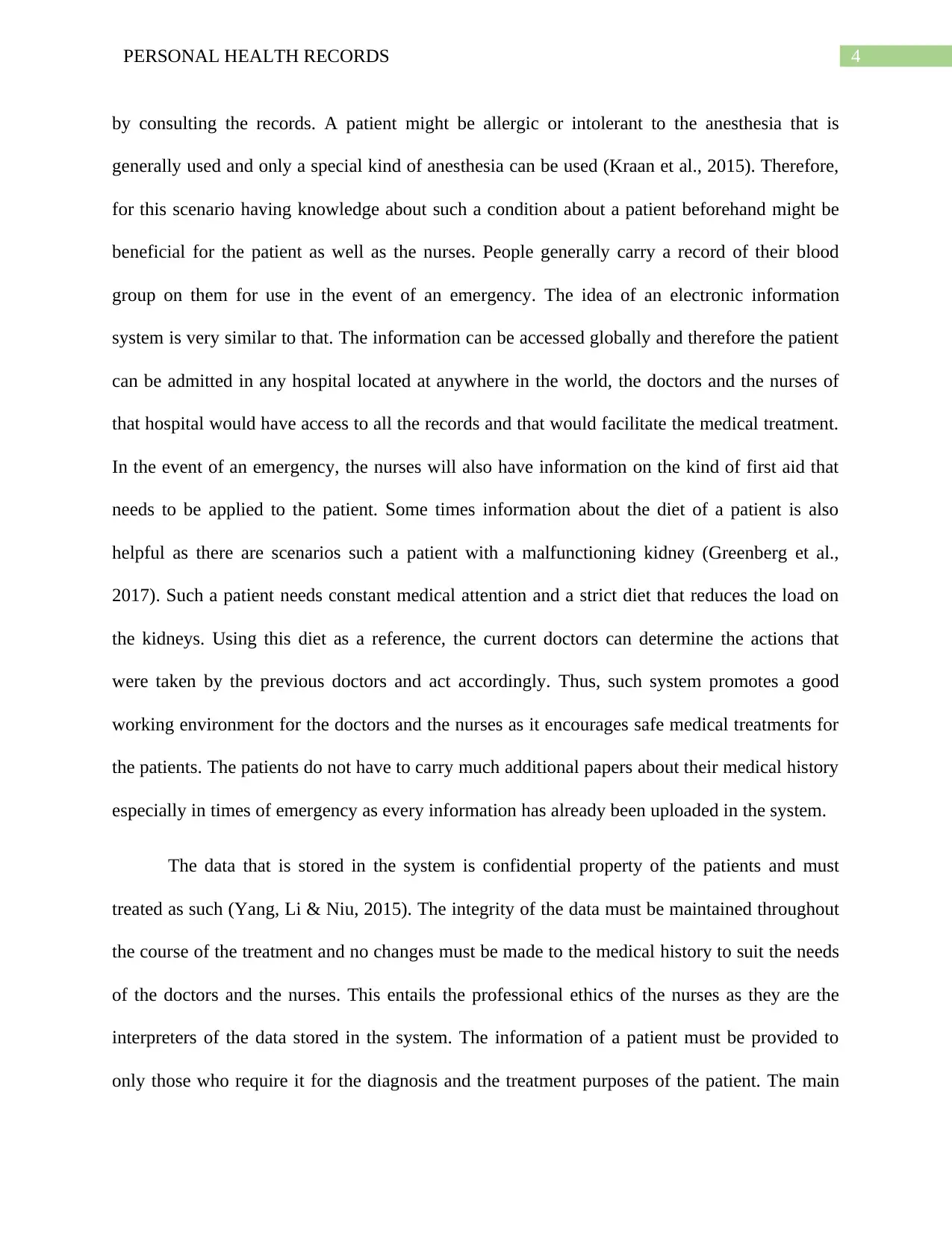
4PERSONAL HEALTH RECORDS
by consulting the records. A patient might be allergic or intolerant to the anesthesia that is
generally used and only a special kind of anesthesia can be used (Kraan et al., 2015). Therefore,
for this scenario having knowledge about such a condition about a patient beforehand might be
beneficial for the patient as well as the nurses. People generally carry a record of their blood
group on them for use in the event of an emergency. The idea of an electronic information
system is very similar to that. The information can be accessed globally and therefore the patient
can be admitted in any hospital located at anywhere in the world, the doctors and the nurses of
that hospital would have access to all the records and that would facilitate the medical treatment.
In the event of an emergency, the nurses will also have information on the kind of first aid that
needs to be applied to the patient. Some times information about the diet of a patient is also
helpful as there are scenarios such a patient with a malfunctioning kidney (Greenberg et al.,
2017). Such a patient needs constant medical attention and a strict diet that reduces the load on
the kidneys. Using this diet as a reference, the current doctors can determine the actions that
were taken by the previous doctors and act accordingly. Thus, such system promotes a good
working environment for the doctors and the nurses as it encourages safe medical treatments for
the patients. The patients do not have to carry much additional papers about their medical history
especially in times of emergency as every information has already been uploaded in the system.
The data that is stored in the system is confidential property of the patients and must
treated as such (Yang, Li & Niu, 2015). The integrity of the data must be maintained throughout
the course of the treatment and no changes must be made to the medical history to suit the needs
of the doctors and the nurses. This entails the professional ethics of the nurses as they are the
interpreters of the data stored in the system. The information of a patient must be provided to
only those who require it for the diagnosis and the treatment purposes of the patient. The main
by consulting the records. A patient might be allergic or intolerant to the anesthesia that is
generally used and only a special kind of anesthesia can be used (Kraan et al., 2015). Therefore,
for this scenario having knowledge about such a condition about a patient beforehand might be
beneficial for the patient as well as the nurses. People generally carry a record of their blood
group on them for use in the event of an emergency. The idea of an electronic information
system is very similar to that. The information can be accessed globally and therefore the patient
can be admitted in any hospital located at anywhere in the world, the doctors and the nurses of
that hospital would have access to all the records and that would facilitate the medical treatment.
In the event of an emergency, the nurses will also have information on the kind of first aid that
needs to be applied to the patient. Some times information about the diet of a patient is also
helpful as there are scenarios such a patient with a malfunctioning kidney (Greenberg et al.,
2017). Such a patient needs constant medical attention and a strict diet that reduces the load on
the kidneys. Using this diet as a reference, the current doctors can determine the actions that
were taken by the previous doctors and act accordingly. Thus, such system promotes a good
working environment for the doctors and the nurses as it encourages safe medical treatments for
the patients. The patients do not have to carry much additional papers about their medical history
especially in times of emergency as every information has already been uploaded in the system.
The data that is stored in the system is confidential property of the patients and must
treated as such (Yang, Li & Niu, 2015). The integrity of the data must be maintained throughout
the course of the treatment and no changes must be made to the medical history to suit the needs
of the doctors and the nurses. This entails the professional ethics of the nurses as they are the
interpreters of the data stored in the system. The information of a patient must be provided to
only those who require it for the diagnosis and the treatment purposes of the patient. The main
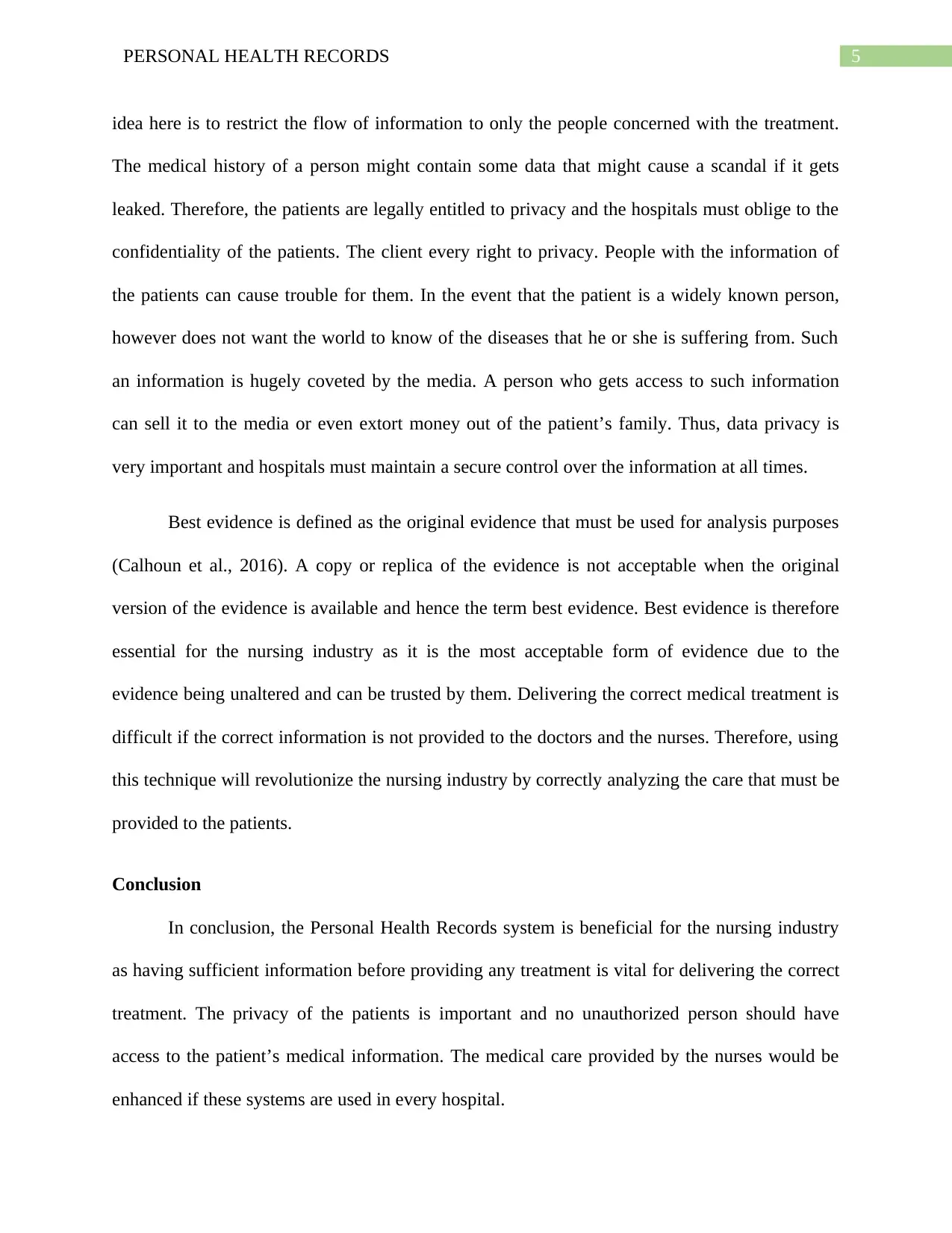
5PERSONAL HEALTH RECORDS
idea here is to restrict the flow of information to only the people concerned with the treatment.
The medical history of a person might contain some data that might cause a scandal if it gets
leaked. Therefore, the patients are legally entitled to privacy and the hospitals must oblige to the
confidentiality of the patients. The client every right to privacy. People with the information of
the patients can cause trouble for them. In the event that the patient is a widely known person,
however does not want the world to know of the diseases that he or she is suffering from. Such
an information is hugely coveted by the media. A person who gets access to such information
can sell it to the media or even extort money out of the patient’s family. Thus, data privacy is
very important and hospitals must maintain a secure control over the information at all times.
Best evidence is defined as the original evidence that must be used for analysis purposes
(Calhoun et al., 2016). A copy or replica of the evidence is not acceptable when the original
version of the evidence is available and hence the term best evidence. Best evidence is therefore
essential for the nursing industry as it is the most acceptable form of evidence due to the
evidence being unaltered and can be trusted by them. Delivering the correct medical treatment is
difficult if the correct information is not provided to the doctors and the nurses. Therefore, using
this technique will revolutionize the nursing industry by correctly analyzing the care that must be
provided to the patients.
Conclusion
In conclusion, the Personal Health Records system is beneficial for the nursing industry
as having sufficient information before providing any treatment is vital for delivering the correct
treatment. The privacy of the patients is important and no unauthorized person should have
access to the patient’s medical information. The medical care provided by the nurses would be
enhanced if these systems are used in every hospital.
idea here is to restrict the flow of information to only the people concerned with the treatment.
The medical history of a person might contain some data that might cause a scandal if it gets
leaked. Therefore, the patients are legally entitled to privacy and the hospitals must oblige to the
confidentiality of the patients. The client every right to privacy. People with the information of
the patients can cause trouble for them. In the event that the patient is a widely known person,
however does not want the world to know of the diseases that he or she is suffering from. Such
an information is hugely coveted by the media. A person who gets access to such information
can sell it to the media or even extort money out of the patient’s family. Thus, data privacy is
very important and hospitals must maintain a secure control over the information at all times.
Best evidence is defined as the original evidence that must be used for analysis purposes
(Calhoun et al., 2016). A copy or replica of the evidence is not acceptable when the original
version of the evidence is available and hence the term best evidence. Best evidence is therefore
essential for the nursing industry as it is the most acceptable form of evidence due to the
evidence being unaltered and can be trusted by them. Delivering the correct medical treatment is
difficult if the correct information is not provided to the doctors and the nurses. Therefore, using
this technique will revolutionize the nursing industry by correctly analyzing the care that must be
provided to the patients.
Conclusion
In conclusion, the Personal Health Records system is beneficial for the nursing industry
as having sufficient information before providing any treatment is vital for delivering the correct
treatment. The privacy of the patients is important and no unauthorized person should have
access to the patient’s medical information. The medical care provided by the nurses would be
enhanced if these systems are used in every hospital.
⊘ This is a preview!⊘
Do you want full access?
Subscribe today to unlock all pages.

Trusted by 1+ million students worldwide
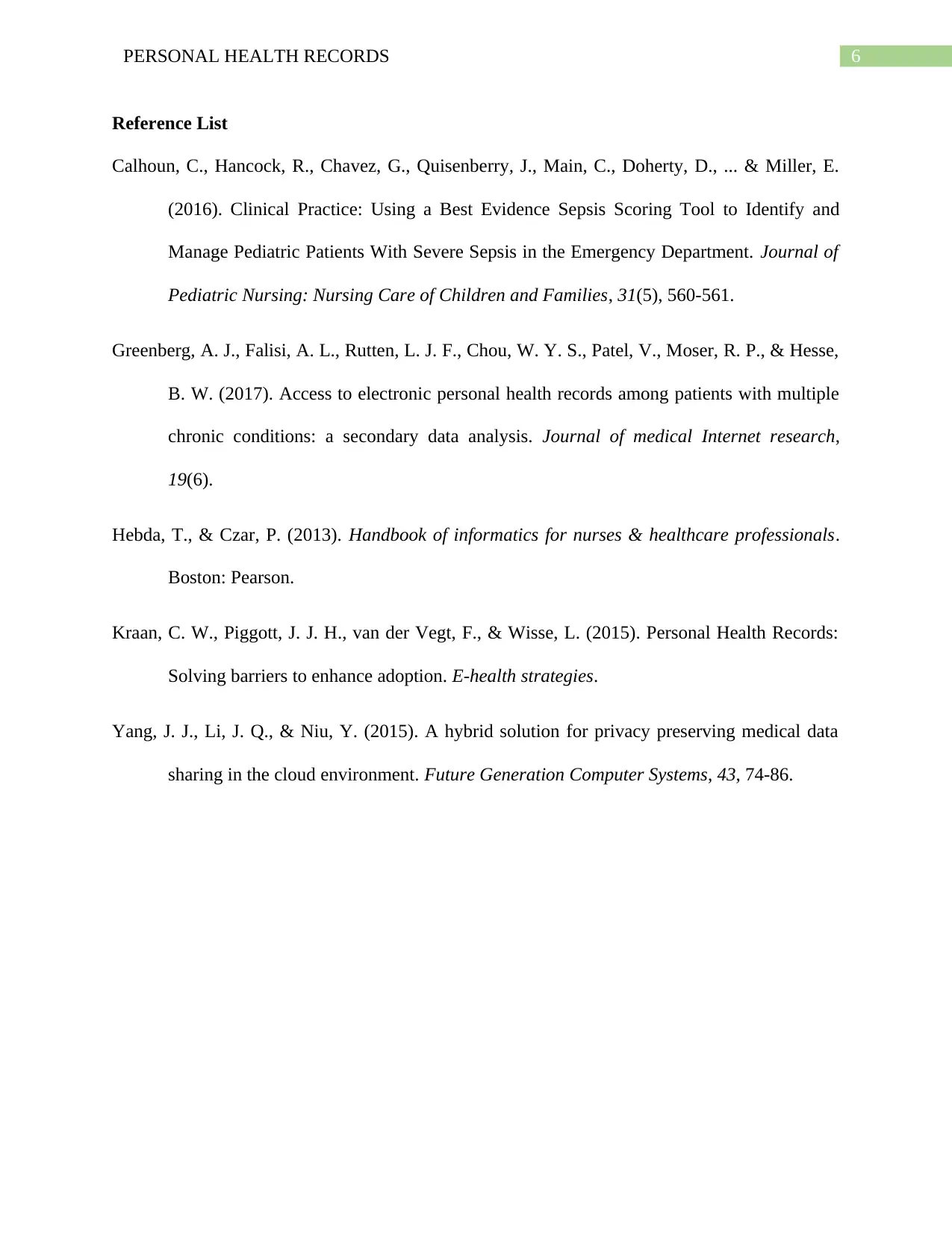
6PERSONAL HEALTH RECORDS
Reference List
Calhoun, C., Hancock, R., Chavez, G., Quisenberry, J., Main, C., Doherty, D., ... & Miller, E.
(2016). Clinical Practice: Using a Best Evidence Sepsis Scoring Tool to Identify and
Manage Pediatric Patients With Severe Sepsis in the Emergency Department. Journal of
Pediatric Nursing: Nursing Care of Children and Families, 31(5), 560-561.
Greenberg, A. J., Falisi, A. L., Rutten, L. J. F., Chou, W. Y. S., Patel, V., Moser, R. P., & Hesse,
B. W. (2017). Access to electronic personal health records among patients with multiple
chronic conditions: a secondary data analysis. Journal of medical Internet research,
19(6).
Hebda, T., & Czar, P. (2013). Handbook of informatics for nurses & healthcare professionals.
Boston: Pearson.
Kraan, C. W., Piggott, J. J. H., van der Vegt, F., & Wisse, L. (2015). Personal Health Records:
Solving barriers to enhance adoption. E-health strategies.
Yang, J. J., Li, J. Q., & Niu, Y. (2015). A hybrid solution for privacy preserving medical data
sharing in the cloud environment. Future Generation Computer Systems, 43, 74-86.
Reference List
Calhoun, C., Hancock, R., Chavez, G., Quisenberry, J., Main, C., Doherty, D., ... & Miller, E.
(2016). Clinical Practice: Using a Best Evidence Sepsis Scoring Tool to Identify and
Manage Pediatric Patients With Severe Sepsis in the Emergency Department. Journal of
Pediatric Nursing: Nursing Care of Children and Families, 31(5), 560-561.
Greenberg, A. J., Falisi, A. L., Rutten, L. J. F., Chou, W. Y. S., Patel, V., Moser, R. P., & Hesse,
B. W. (2017). Access to electronic personal health records among patients with multiple
chronic conditions: a secondary data analysis. Journal of medical Internet research,
19(6).
Hebda, T., & Czar, P. (2013). Handbook of informatics for nurses & healthcare professionals.
Boston: Pearson.
Kraan, C. W., Piggott, J. J. H., van der Vegt, F., & Wisse, L. (2015). Personal Health Records:
Solving barriers to enhance adoption. E-health strategies.
Yang, J. J., Li, J. Q., & Niu, Y. (2015). A hybrid solution for privacy preserving medical data
sharing in the cloud environment. Future Generation Computer Systems, 43, 74-86.
1 out of 7
Related Documents
Your All-in-One AI-Powered Toolkit for Academic Success.
+13062052269
info@desklib.com
Available 24*7 on WhatsApp / Email
![[object Object]](/_next/static/media/star-bottom.7253800d.svg)
Unlock your academic potential
Copyright © 2020–2026 A2Z Services. All Rights Reserved. Developed and managed by ZUCOL.





